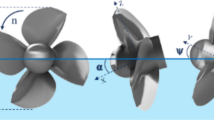Abstract
Unconventional propellers with end-plate effects such as Kappel propellers get designers’ attention due to the environmental concerns and energy saving problems. The computations have been carried out to compare the Kappel propellers and the conventional propellers, and the emphasis is put on the scale effects and the structural performance. The scale-effect is first investigated, and the computational results show that the Kappel propeller has a larger scale effect than the conventional propeller. The structural analysis is then made, and the comparisons of the Kappel propeller and the conventional propeller show that the Kappel propeller suffers from a stronger stress concentration near the tip.
Similar content being viewed by others
References
Dang J. Improving Cavitation Performance with New Blade Sections for Marine Propellers. Int’l Shipbuilding Progress. 2004,51.
Spareberg J A, de Vries J. An Optimum Screw Porpeller with Endplates. International Shipbuilding Progress, 1987, 34(395): 124–133.
Kappel J, Andersen P. KAPPEL Propeller. Development of a Marine Propeller with Non-planar Lifting Surfaces. Proceedings of The 24th Motor Ship Marine Propulsion Conference, 2002.
Andersen P, Friesch J, Kappel J J, et al. Development of a Marine Propeller With Nonplanar Lifting Surfaces. Marine Technology, 2005, 42(3): 144–158.
Gómez G P, González Linares F, Baquerizo Briones I. Some improvements of the traditional lifting theory of the ship propeller. International Shipbuilding Progress, July 1980.
Gómez G P, González-Adalid J. Tip loaded propellers(CLT. Justification of their advantages over conventional propellers using the momentum theory). International Shipbuilding Progress, 1995, 42: 429.
Andersen P, Friesch J, Kappel J J. Development and Full-Scale Evaluation of a New Marine Propeller Type. 97th Hauptversammlung der Schiffbautechnischen Gesellschaft, Hamburg, 2002.
Friesch J, Andersen P, Kappel J J. Model/Full Scale Correlation Investigations for a New Marine Propeller. NAV 2003, Palermo, Italy, 2003.
Hsin C-Y, Chang K-K, Cheng Y-H, et al. The Analysis and Design of Energy-Saving Propulsors by Computational Methods. The 3rd Pan Asian Association of Maritime Engineering Societies (3rd PAAMES) and Advanced Maritime Engineering Conference 2008 (AMEC 2008), Chiba, Japan, Oct. 20–22, 2008.
Sánchez-Caja A, Sipilä T P, Pylkkänen J V. Simulation of the Incompressible Viscous Flow around an Endplate Propeller Using a RANSE Solver. 26th Symposium on Naval Hydrodynamics Rome, Italy, 17–22, 2006.
Author information
Authors and Affiliations
Corresponding author
Rights and permissions
About this article
Cite this article
Cheng, Hj., Chien, Yc., Hsin, Cy. et al. A numerical comparison of end-plate effect propellers and conventional propellers. J Hydrodyn 22 (Suppl 1), 478–483 (2010). https://doi.org/10.1016/S1001-6058(09)60242-0
Published:
Issue Date:
DOI: https://doi.org/10.1016/S1001-6058(09)60242-0




